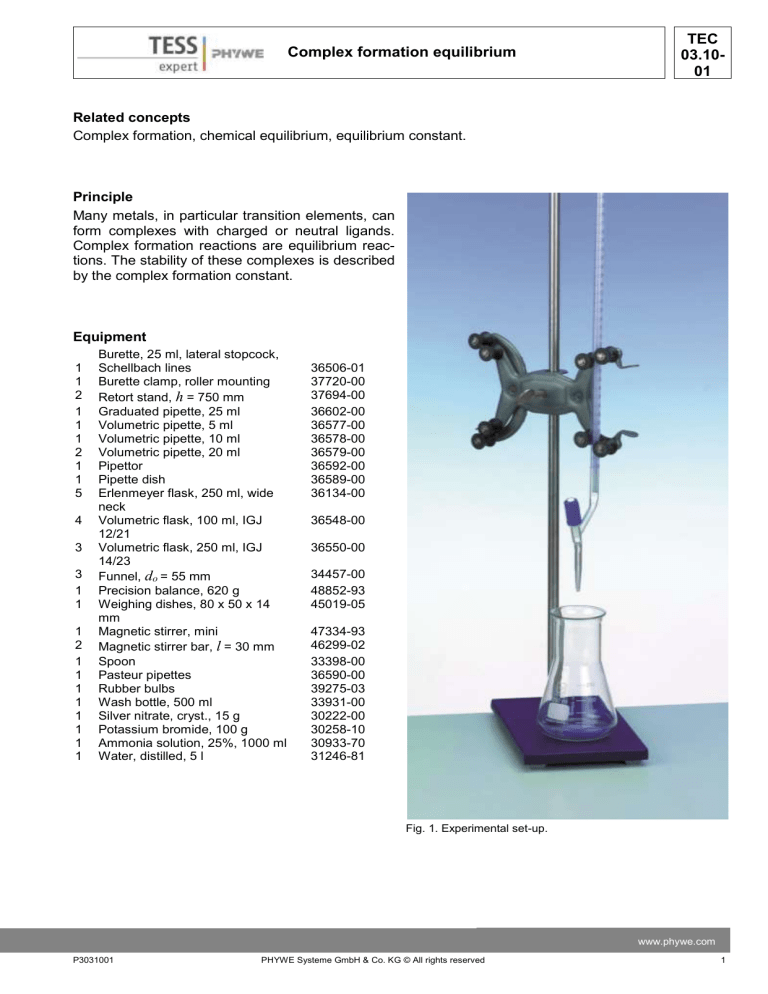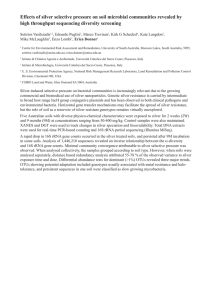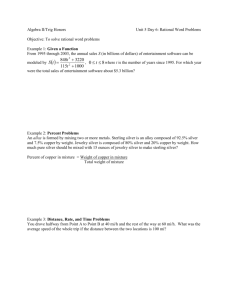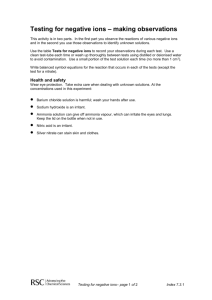TEC 03.10-01 Complex formation equilibrium TEC 03.10

Complex formation equilibrium
Related concepts
Complex formation, chemical equilibrium, equilibrium constant.
Principle
Many metals, in particular transition elements, can form complexes with charged or neutral ligands.
Complex formation reactions are equilibrium reactions. The stability of these complexes is described by the complex formation constant.
Equipment
Burette, 25 ml, lateral stopcock,
1 Schellbach lines
1 Burette clamp, roller mounting
2 Retort stand, h = 750 mm
1 Graduated pipette, 25 ml
1 Volumetric pipette, 5 ml
1 Volumetric pipette, 10 ml
2 Volumetric pipette, 20 ml
1 Pipettor
1 Pipette dish
5 Erlenmeyer flask, 250 ml, wide neck
4 Volumetric flask, 100 ml, IGJ
36506-01
37720-00
37694-00
36602-00
36577-00
36578-00
36579-00
36592-00
36589-00
36134-00
36548-00
12/21
3 Volumetric flask, 250 ml, IGJ
14/23
3
Funnel, d o
= 55 mm
1 Precision balance, 620 g
1 Weighing dishes, 80 x 50 x 14 mm
1 Magnetic stirrer, mini
2 Magnetic stirrer bar, l = 30 mm
36550-00
34457-00
48852-93
45019-05
47334-93
46299-02
1 Spoon
1 Pasteur pipettes
1 Rubber bulbs
1 Wash bottle, 500 ml
33398-00
36590-00
39275-03
33931-00
1 Silver nitrate, cryst., 15 g
1 Potassium bromide, 100 g
30222-00
30258-10
1 Ammonia solution, 25%, 1000 ml 30933-70
1 Water, distilled, 5 l 31246-81
Fig. 1. Experimental set-up.
TEC
03.10-
01
P3031001 www.phywe.com
PHYWE Systeme GmbH & Co. KG © All rights reserved 1
TEC
03.10-
01
Complex formation equilibrium
Tasks
Determine the number of ligands of the silver amine complex with a precipitation titration from a silver salt solution.
Set-up and procedure
Set up the experiment as shown in Fig. 1.
Prepare the solutions required for the experiment as follows:
-
0.01 molar silver nitrate solution: Weigh 0.425 g of silver nitrate in a 250 ml volumetric flask, dissolve it in approximately 100 ml of distilled water and fill up to the calibration mark with distilled water.
-
-
0.01 potassium bromide solution: Weigh 0.298 g of potassium bromide in a 250 ml volumetric flask, dissolve it in approximately 100 ml of distilled water, and fill up to the calibration mark with distilled water.
2 molar ammonia solution: Pipette 37.5 ml of 25 % molar ammonia solution into a 250 ml volumetric flask, dilute it with distilled water, and fill up to the calibration mark with distilled water.
Pipette 20 ml of the 0.01 M silver nitrate solution into each of the four 100 ml flasks, add 10, 15, 20 and
30 ml respectively of 2 molar ammonia solution and fill up to the calibration mark with distilled water.
Transfer each of these four solutions into a separate 250 ml Erlenmeyer flask and successively titrate each of them with 0.01 molar potassium bromide solution until the solution becomes slightly cloudy
(compare it with pure water).
To calculate the equilibrium concentrations, take the total volume of the respective solution into account
– including the potassium bromide solution used.
Theory and evaluation
Complexes are chemical compounds which consist of a central atom and a definite number of ligands.
The central atom is normally a metal ion, transition metals in particular frequently form complexes. The ligands can be charged ions (anions) or neutral molecules. The formation of a complex can be perceived to be a Lewis acidbase reaction. The ligands, with their free pairs of electrons, represent the Lewis bases, while the central atom with its free orbitals functions as an acid. A complex is formed with atomic bonds between the ligands and the central atom, whereby the pairs of electrons only come from one partner, the ligand.. Complex formation can be described by the following equation:
Where n Number of ligands
For this experiment the complex formation reaction is
2 PHYWE Systeme GmbH & Co. KG © All rights reserved P3031001
Complex formation equilibrium
TEC
03.10-
01 in which the number of ligands is to be determined. The complex formation constant can be calculated according to the law of mass action:
Transformed to the logarithmic form, the following results:
Because ammonia is added in excess to the four silver nitrate solutions, the concentration of ammonia is much higher than the concentration of silver nitrate:
According to this we can assume that the concentration of the silver complex is nearly equal to the total concentration of silver ions in the solution and further, that the concentration of free ammonia after the complex formation reaction is nearly equal to the total concentration of ammonia:
With equations (5), (6) and (7), equation (3) simplifies to
After the complex formation reaction some of the silver ions remain in the solution as free silver ions
(without ammonia ligands). The amount of these free silver ions can be determined by titration with potassium bromide solution. The titration is stopped when the solution begins to become cloudy (onset of precipitation, some solid silver bromide is formed). At this moment the maximum solubility of the silver bromide is reached. This is described by the solubility product:
P3031001 www.phywe.com
PHYWE Systeme GmbH & Co. KG © All rights reserved 3
TEC
03.10-
01
Complex formation equilibrium
Combining (8) and (9), we obtain:
The concentration of silver nitrate is constant in the four solutions:
So it follows:
Combining equations (10) and (12), we obtain:
This means that the number of ligands in the silver amine complex can be obtained from the slope of the plot log c (Br ) against c (NH
3
).
Data and results
Example for a measurement series (see Table 1):
Table 1.
1 Solution number
Volume of 0.01 M silver nitrate solution
V (AgNO
3
)
Volume of 2 M ammonia solution V (NH 3 )
Number of moles of ammonia n (NH
3
) = V (NH
3
) · c
0
(NH
3
)
Volume of added water
V
(H 2 O)
Volume of resulting solution V (solution)
Added volume of 0.01 M potassium bro-
20 ml
10 ml
0.02 mol
70 ml
100 ml
1.30 ml
2
20 ml
15 ml
0.03 mol
65 ml
100 ml
2.55 ml
3
20 ml
20 ml
0.04 mol
60 ml
100 ml
4.20 ml
4
20 ml
30 ml
0.06 mol
50 ml
100 ml
12.40 ml
4 PHYWE Systeme GmbH & Co. KG © All rights reserved P3031001
Complex formation equilibrium
TEC
03.10-
01
Fig. 2: Determination of the number of ligands bound in the complex mide solution V (KBr)
Number of moles of added potassium bromide n (KBr) = V (KBr) · c (KBr)
Total volume of the solution after titration
V (total) = V (solution) + V (KBr)
Concentration of ammonia in the solution after titration c (NH 3 ) = n (NH 3 ) / V (total) log c (NH
3 ; total
)
Concentration of bromide ions in the solution after titration c (Br ) = n (KBr) / V (total) log c (Br )
1.3 · 10 -5 mol
101.30 ml
0.1974 mol/l
- 0.7047
1.2833 · 10 -4 mol/l 2.4378 · 10 -4 mol/l 4.0307 · 10 -4 mol/l
- 3.8917
2.5 · 10 -5 mol
102.55 ml
0.2925 mol/l
- 0.5339
- 3.6130
4.2 · 10 -5 mol
104.20 ml
0.3839 mol/l
- 0.4158
- 3.3946
The slope of the curve (Fig. 2) is 2.07, hence the co-ordination number for silver is 2.
12.4 · 10 -5 mol
112.40 ml
0.5338 mol/l
- 0.2726
11.0320 · 10 -4 mol/l
- 2.9573
If ammonia is added to a silver nitrate solution, therefore, the water molecules which are bound to the silver ion (aquo complex) are displaced by ammonia molecules and a silver diamine complex is formed:
P3031001 www.phywe.com
PHYWE Systeme GmbH & Co. KG © All rights reserved 5
TEC
03.10-
01
Complex formation equilibrium
6 PHYWE Systeme GmbH & Co. KG © All rights reserved P3031001







